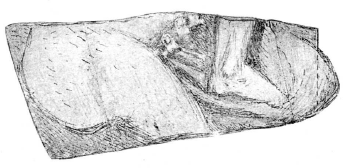No CrossRef data available.
Published online by Cambridge University Press: 23 December 2013
When I wrote my former notes I was undecided as to the meaning of two of the sculptured fragments. No. 1215 is described in the Catalogue as ‘Fragment of sculptured pier, with portions of two figures wrestling; one is half kneeling, and his left thigh is clasped by the hand of his opponent—perhaps the contest of Herakles and Antaeus.’ (Fig. 1.)
The high relief shows that the fragment indeed belonged to a pedestal, and in re-examining it more carefully I find that a portion of the right-hand return still exists. Small as the trace is, it is enough to fix the place of the fragment in regard to the angle of the pedestal together with the vertical direction. It is plain, further, that the hand which grasps the leg is a left hand.

1 This suggestion was first made by Dr.Murray, , R.I.B.A. Jour. 1895.Google Scholar
2 MissHarrison's, Mythology and Monuments, p. 291.Google Scholar
3 See Roscher's, Dictionary, iii. p. 246.Google Scholar
4 Pontremoli, and Haussoullier, , Didymes, p. 153.Google Scholar
5 In the recently published Fifth Part of Antiquities of Ionia I have stated that Priene had similar walling-stones. This was a mistake for Teos.
6 Ath. Mitth. 1914.